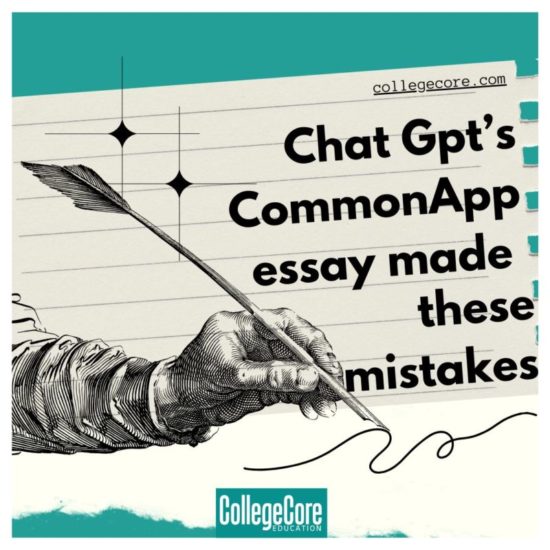
With the rising prevalence of AI in the education sector, admissions officers are becoming more and more sensitised to identifying AI-generated content. Here’s a list of mistakes Chat Gpt made while writing the Common App essay.
Mistake #1: The essay tells rather than shows.
The essays written by chat GPT are often repetitive and lack characterization, dialogue, and imagery. These essays mostly tell the reader the intended message directly rather than showcasing the specific incidences that shaped students’ personal development and insights. For example, this GPT-generated sentence, “I am driven by a profound curiosity to unravel the complexities of human behavior and the intricate workings of the mind”, doesn’t provide specific details about what initially sparked the student’s interest in the field. Moreover, it fails to mention how challenges such as anxiety deepened the student’s interest in the psychological sciences.
Mistake #2: The language is vague and impersonal.
Since college essays have a specific word or character limit, every sentence should add valuable information or paint a vivid portrait of the student, highlighting not just their achievements but also challenges. This requirement contradicts the stylistic quality of GPT compositions as they are broad, vague, impersonal, and generic. While a strong essay will give concrete details and a critical analysis of the student’s personal backgrounds, interests, reasons, and inclinations, AI content tends to lack these specific insights, presenting more generalized and surface-level reflections.
Mistake #3: The essay doesn’t follow a cohesive theme.
A cohesive theme is the backbone of an effective essay, guiding the reader about the author’s intention and providing a straightforward and engaging narrative. AI-generated essays lack this approach and read like a collection of unrelated thoughts without a theme. Moreover, these essays don’t build upon previous points and can hinder the admission committee’s understanding of students’ experiences, challenges, growth, value systems, journeys, and aspirations, failing to leave a lasting impact on them and giving the impression that the student lacks focus.
Mistake #4: The writing lacks a distinct voice and unique perspective.
University prompts serve the purpose of delving deeper into the experiences and journeys of students. These prompts help the admission committee connect with prospective students personally and provide a more memorable and genuine narrative. By showcasing their achievements and who they are at the core, students can offer a glimpse into their world and highlight their unique stories, allowing them to stand out from the pool of talented candidates. However, AI-generated compositions lack this personal essence, making them less effective in conveying the narratives that universities seek.
Mistake #5: The conclusion provides new insights
A strong essay must bring the story to the full circle in the conclusion. This can be done by weaving together all the points, themes, and discussions together from the previous paragraphs to reinforce the overarching message. This technique also means that no new point should be added in the summary, a common pitfall in AI-generated content.
In conclusion, while ChatGPT can aid students in researching and refining their ideas for essays, it cannot replace the human touch.